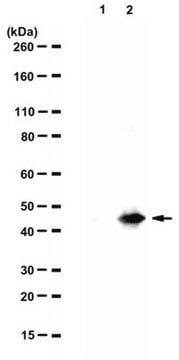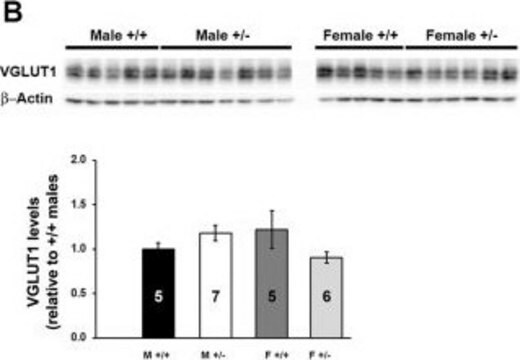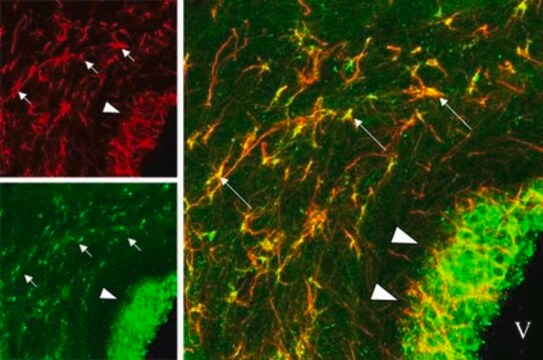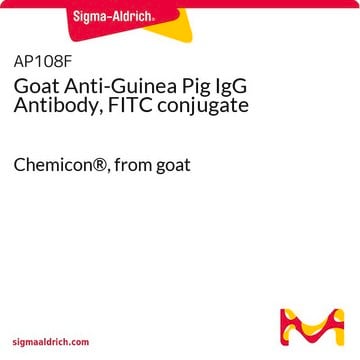ABN1642
Anti-APP Antibody, AEP-cleaved (585N)
serum, from rabbit
Sinónimos:
Amyloid beta A4 protein, 585N fragment, ABPP, 585N fragment, Alzheimer disease amyloid protein, 585N fragment, Amyloid precursor protein, 585N fragment, APP, 585N fragment, APPI, 585N fragment, Cerebral vascular amyloid peptide, 585N fragment, CVAP, 585N
About This Item
Productos recomendados
origen biológico
rabbit
Nivel de calidad
forma del anticuerpo
serum
tipo de anticuerpo
primary antibodies
clon
polyclonal
reactividad de especies
mouse, human
reactividad de especies (predicha por homología)
rabbit (based on 100% sequence homology), nonhuman primates (based on 100% sequence homology), canine (based on 100% sequence homology), guinea pig (based on 100% sequence homology), porcine (based on 100% sequence homology)
técnicas
immunohistochemistry: suitable
western blot: suitable
Nº de acceso NCBI
Nº de acceso UniProt
Condiciones de envío
ambient
modificación del objetivo postraduccional
unmodified
Información sobre el gen
human ... APP(351)
Descripción general
Especificidad
Inmunógeno
Aplicación
Western Blotting Analysis: A 1:1,000 dilution from a representative lot detected APP N-terminal fragment 585N in brain tissue lysates from 5XFAD familial AD transgenic mice, but not from AEP-knockout 5XFAD mice (Courtesy of Dr. Keqiang Ye, Emory University, U.S.A.).
Western Blotting Analysis: A representative lot detected an increased APP N-terminal fragment 585N in AEP-containing brain fractions from 5-month-old 5XFAD familial AD transgenic mice than wild-type mice. No APP 585N fragment was detected in Aep-/- mice (Zhang, Z., et al. (2015). Nat. Commun. 6:8762).
Western Blotting Analysis: A representative lot detected an age-dependent increase of brain APP N-terminal fragment 585N in mice. Upregulated APP 585N fragment level was seen in human AD brain samples when compared with age-matched non-AD brains (Zhang, Z., et al. (2015). Nat. Commun. 6:8762).
Western Blotting Analysis: A representative lot detected AEP-cleaved recombinant GST-APP N-terminal fragment, but not the uncleaved GST-APP or the cleaved C-terminal fragment (Zhang, Z., et al. (2015). Nat. Commun. 6:8762).
Western Blotting Analysis: A representative lot detected AEP-cleaved APP N-terminal fragment 585N in untransfected, but not AEP siRNA-transfected, HEK293 cells (Zhang, Z., et al. (2015). Nat. Commun. 6:8762).
Neuroscience
Calidad
Western Blotting Analysis: A 1:1,000 dilution of this antiserum detected APP(1-585), but not APP(1-373) or full-length APP, GST fusion exogenously expressed in HEK293 cells.
Descripción de destino
Forma física
Almacenamiento y estabilidad
Handling Recommendations: Upon receipt and prior to removing the cap, centrifuge the vial and gently mix the solution. Aliquot into microcentrifuge tubes and store at -20°C. Avoid repeated freeze/thaw cycles, which may damage IgG and affect product performance.
Otras notas
Cláusula de descargo de responsabilidad
Not finding the right product?
Try our Herramienta de selección de productos.
Opcional
Código de clase de almacenamiento
12 - Non Combustible Liquids
Clase de riesgo para el agua (WGK)
WGK 1
Punto de inflamabilidad (°F)
Not applicable
Punto de inflamabilidad (°C)
Not applicable
Certificados de análisis (COA)
Busque Certificados de análisis (COA) introduciendo el número de lote del producto. Los números de lote se encuentran en la etiqueta del producto después de las palabras «Lot» o «Batch»
¿Ya tiene este producto?
Encuentre la documentación para los productos que ha comprado recientemente en la Biblioteca de documentos.
Nuestro equipo de científicos tiene experiencia en todas las áreas de investigación: Ciencias de la vida, Ciencia de los materiales, Síntesis química, Cromatografía, Analítica y muchas otras.
Póngase en contacto con el Servicio técnico







